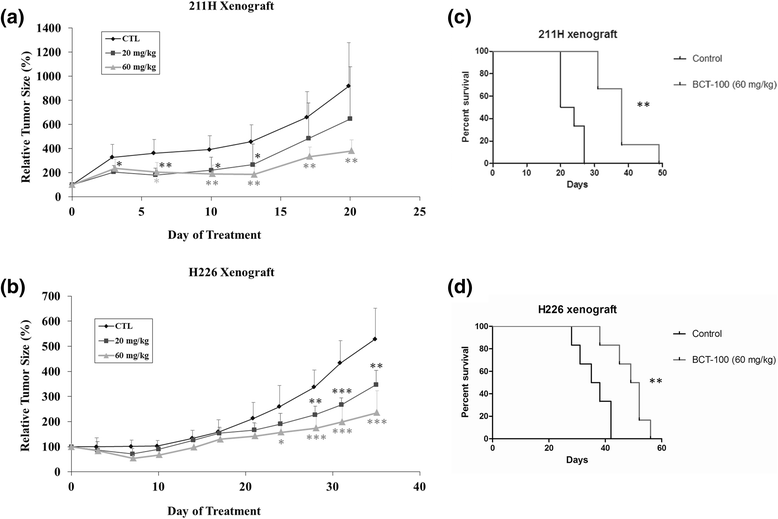Growth suppressive effect of pegylated arginase in malignant pleural mesothelioma xenografts
- PMID: 28464918
- PMCID: PMC5414232
- DOI: 10.1186/s12931-017-0564-3
Growth suppressive effect of pegylated arginase in malignant pleural mesothelioma xenografts
Abstract
Background: Malignant pleural mesothelioma (MPM) is a difficult-to-treat global disease. Pegylated arginase (BCT-100) has recently shown anti-tumor effects in hepatocellular carcinoma, acute myeloid leukemia and melanoma. This study aims to investigate the effects of PEG-BCT-100 in MPM.
Methods: A panel of 5 mesothelioma cell lines (H28, 211H, H226, H2052 and H2452) was used to study the in vitro effects of BCT-100 by crystal violet staining. The in vivo effects of BCT-100 were studied using 211H and H226 nude mice xenografts. Protein expression (argininosuccinate synthetase, ornithine transcarbamylase, cleaved PARP, cleaved caspase 3, cyclins (A2, D3, E1 and H), CDK4 and Ki67) and arginine concentration were evaluated by Western blot and ELISA respectively. Cellular localization of BCT-100 was detected by immunohistochemistry and immunoflorescence. TUNEL assay was used to identify cellular apoptotic events.
Results: Argininosuccinate synthetase was expressed in H28, H226, and H2452 cells as well as 211H and H266 xenografts. Ornithine transcarbamylase was undetectable in all cell lines and xenograft models. BCT-100 reduced in vitro cell viability (IC50 values at 13-24 mU/ml, 72 h) across different cell lines and suppressed tumor growth in both 211H and H226 xenograft models. BCT-100 (60 mg/kg) significantly suppressed tumor growth (p < 0.01) with prolonged median survival (p < 0.01) in both xenograft models. Combining BCT-100 with pemetrexed or cisplatin conferred no additional benefits over single agents. Serum and intratumoral arginine levels were effectively decreased by BCT-100, associated with cytosolic accumulation of BCT-100 within tumor cells. Apoptosis (PARP cleavage in 211H xenografts; Bcl-2 downregulation, and cleavage of PARP and caspase 3 in H226 xenografts; positive TUNEL staining in both) and G1 arrest (downregulation of cyclin A2, D3, E1 and CDK4 in 211H xenografts; suppression of cyclin A2, E1, H and CDK4 in H226 xenografts) were evident with BCT-100 treatment. Furthermore, proliferative factor Ki67 was downregulated in BCT-100 treatments arms.
Conclusions: BCT-100 suppressed tumor growth with prolonged median survival partially mediated by intratumoral arginine depletion resulting in apoptosis and G1 arrest in mesothelioma xenograft models. The findings provide scientific evidence to support further clinical development of BCT-100 in treatment of MPM.
Keywords: Apoptosis; BCT-100; Cell cycle arrest; Mesothelioma; Pegylated arginase; Xenografts.
Figures





Similar articles
-
Inhibition of ornithine decarboxylase 1 facilitates pegylated arginase treatment in lung adenocarcinoma xenograft models.Oncol Rep. 2018 Oct;40(4):1994-2004. doi: 10.3892/or.2018.6598. Epub 2018 Jul 25. Oncol Rep. 2018. PMID: 30066894 Free PMC article.
-
Downregulation of thymidylate synthase and E2F1 by arsenic trioxide in mesothelioma.Int J Oncol. 2015 Jan;46(1):113-22. doi: 10.3892/ijo.2014.2716. Epub 2014 Oct 21. Int J Oncol. 2015. PMID: 25335113
-
Cisplatin potentiates PD-L1 expression more robustly than pemetrexed in malignant pleural mesothelioma: Temporal dynamics revealed by cellular and xenograft analyses.Pathol Res Pract. 2025 Jul;271:156048. doi: 10.1016/j.prp.2025.156048. Epub 2025 May 27. Pathol Res Pract. 2025. PMID: 40441085
-
Molecular Pharmacology of Malignant Pleural Mesothelioma: Challenges and Perspectives From Preclinical and Clinical Studies.Curr Drug Targets. 2016;17(7):824-49. doi: 10.2174/1389450116666150804110714. Curr Drug Targets. 2016. PMID: 26240051 Review.
-
The role of BCL-2 family proteins and therapeutic potential of BH3-mimetics in malignant pleural mesothelioma.Expert Rev Anticancer Ther. 2021 Apr;21(4):413-424. doi: 10.1080/14737140.2021.1856660. Epub 2020 Dec 10. Expert Rev Anticancer Ther. 2021. PMID: 33238762 Review.
Cited by
-
A bioengineered arginine-depleting enzyme as a long-lasting therapeutic agent against cancer.Appl Microbiol Biotechnol. 2020 May;104(9):3921-3934. doi: 10.1007/s00253-020-10484-4. Epub 2020 Mar 6. Appl Microbiol Biotechnol. 2020. PMID: 32144472
-
Unlocking the Potential of Arginine Deprivation Therapy: Recent Breakthroughs and Promising Future for Cancer Treatment.Int J Mol Sci. 2023 Jun 26;24(13):10668. doi: 10.3390/ijms241310668. Int J Mol Sci. 2023. PMID: 37445845 Free PMC article. Review.
-
Mouse models for mesothelioma drug discovery and development.Expert Opin Drug Discov. 2021 Jun;16(6):697-708. doi: 10.1080/17460441.2021.1867530. Epub 2020 Dec 31. Expert Opin Drug Discov. 2021. PMID: 33380218 Free PMC article. Review.
-
In Vitro Characterization of Cisplatin and Pemetrexed Effects in Malignant Pleural Mesothelioma 3D Culture Phenotypes.Cancers (Basel). 2019 Sep 27;11(10):1446. doi: 10.3390/cancers11101446. Cancers (Basel). 2019. PMID: 31569615 Free PMC article.
-
The Role and Treatment Strategies of Ammonia-Related Metabolism in Tumor Microenvironment.Curr Gene Ther. 2025;25(3):199-209. doi: 10.2174/0115665232301222240603100840. Curr Gene Ther. 2025. PMID: 38860905 Review.
References
-
- Abakay A, Abakay O, Tanrikulu AC, Sezgi C, Sen H, Kaya H, Kucukoner M, Kaplan MA, Celik Y, Senyigit A. Effects of treatment regimens on survival in patients with malignant pleural mesothelioma. Eur Rev Med Pharmacol Sci. 2013;17:19–24. - PubMed
-
- Delage B, Fennell DA, Nicholson L, McNeish I, Lemoine NR, Crook T, Szlosarek PW. Arginine deprivation and argininosuccinate synthetase expression in the treatment of cancer. Int J Cancer. 2010;126:2762–2772. - PubMed
-
- Chow AK, Ng L, Sing Li H, Cheng CW, Lam CS, Yau TC, Cheng PN, Fan ST, Poon RT, Pang RW. Anti-tumor efficacy of a recombinant human arginase in human hepatocellular carcinoma. Curr Cancer Drug Targets. 2012;12:1233–1243. - PubMed
MeSH terms
Substances
LinkOut - more resources
Full Text Sources
Other Literature Sources
Medical
Research Materials

